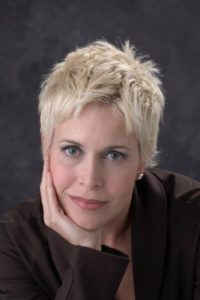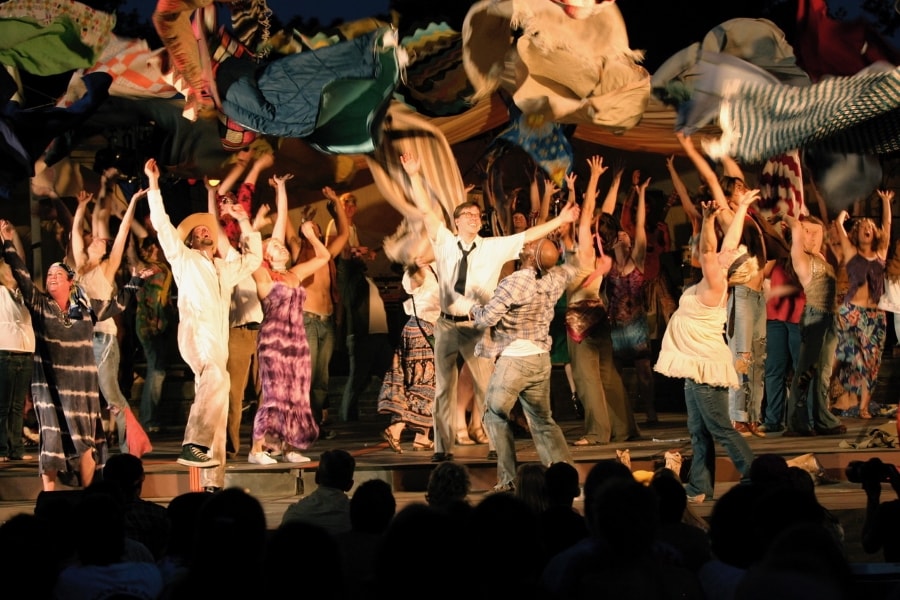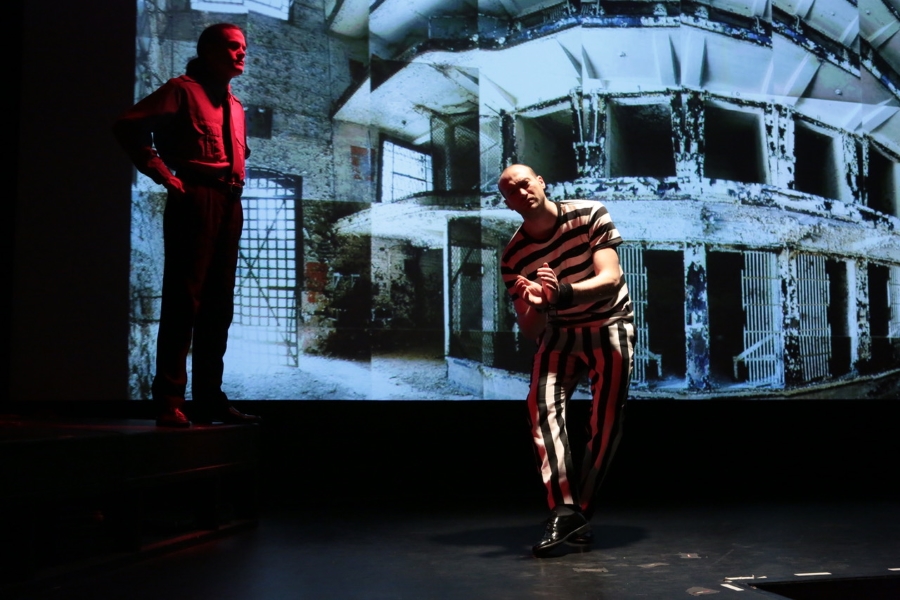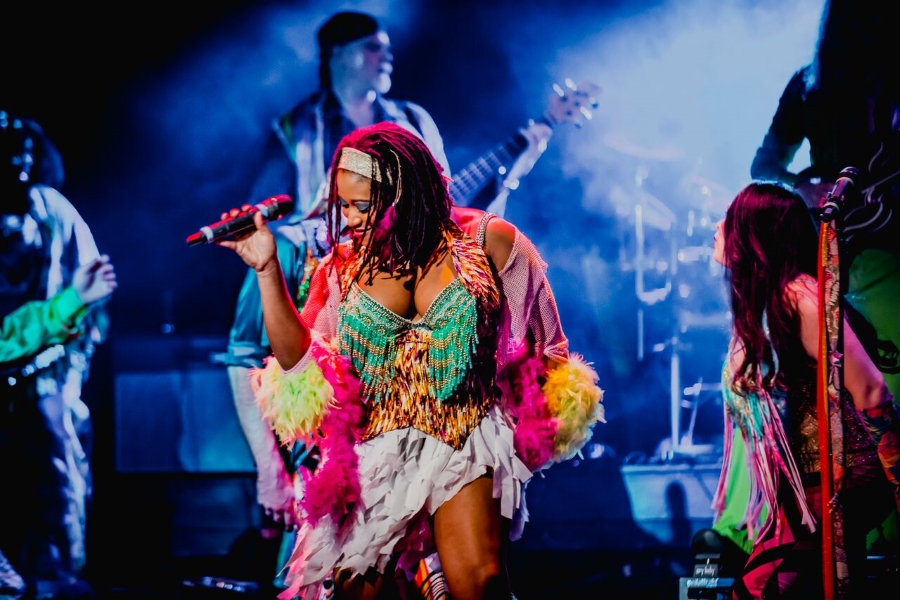COLUMBUS, OHIO: Ohio’s state capital is one of the fastest-growing cities in the U.S. Its first boom was in the late 1800s, when this city on the Scioto River became home to a froth of breweries. Today the historic Brewery District is a hub for business and entertainment. Among this throng is Shadowbox Live, a year-round production theatre with a robust education program.
“This current revitalization has turned it into this great area where you can walk the streets checking out the 19th-century architecture, visit cool little boutiques like Helen Winnamore’s, restaurants with Czech, German, or Brazilian foods, or bike and play along a riverfront nature preserve that has a spectacular view of the skyline,” says Stacie Boord, the company’s executive director. American Theatre caught up with Boord to learn more about producing theatre in the Buckeye State.

Who founded the Shadowbox Live, when, and why?
Stev Guyer and his then partner Rebecca Gentile founded the company in 1988 when Stev had written a rock opera called Dawn of Infinite Dreams. As they moved forward in producing the work they connected with people who saw the potential of using rock music to tell a compelling story. Truth be told, the first effort was very flawed, even comical in some parts! But thankfully our passion outweighed our talent and we wanted to work on refining the art form. The group continued to revise the work, and on the third iteration finally received good reviews. That laid the groundwork for company to continue creating/revising original work and pushing the artistic boundaries.
Tell us about yourself and your connection to the company.
As Stev was casting that first show, he contacted the opera department at the Ohio State University to find student singers willing to participate in a rock opera. I was one of the few singers that even considered it. My intention was to do it, put it on my résumé to show my versatility, then move on and take the classical world by storm (hair flip). Well, 30 years later, here I am. Clearly, I didn’t move on. But I, along with my colleagues, are certainly taking the world by storm! I consider myself incredibly blessed to do what I do. I have an amazing career here at Shadowbox Live, which has allowed me to stretch myself artistically, administratively, and personally.
In the beginning I was the youngest member of our leadership team by about 12 years. I lacked experience, but I made up for it with my energy and passion for what we were doing. When we took our third project EVO to New York City for an Off-Broadway run at Tribeca Performing Arts Center, everyone advised us to hire a PR firm, but we couldn’t afford it. So I took on my first official title: public relations director. In my new role I got us coverage in The New York Times, Time Out New York, and Swing Magazine. We also made it on “Good Morning America,” where we were named “The Hot New Show of 1997” (but should have been named, “The Hot New Show of 1997 That No One Has Heard Of”). We weren’t the biggest box-office smash hit, but the whole experience taught me that if you work hard, surround yourself with amazing people, and listen to your heart, you can accomplish the impossible. Through the years I’ve served as corporate events director, dramaturg, education and community relations director, special events director, vocal master, director of development, and now executive director. It’s been a crazy, wonderful journey. I’m truly inspired every day by the work we create, the students we teach, the partnerships we develop, and the amazing talent exhibited everyday by my colleagues.

(Photo by Mark Bealer)
How did the theatre get its name? Is any boxing involved?
(Laughs) No boxing! Though I’m confident that would make a great story. Initially we named the company Shadow Productions because we had connected with the local performing arts magnet school and created an education component, where students “shadowed” us as we mounted this original rock production. When the revision process of the production was over, we realized we needed to open a black box theatre where we could continue to hone our artistic skills. Initially we were just presenting one-act plays, so we named ourselves Shadowbox Theatre. Then we started creating “themed” shows by incorporating music into the productions and offering food and beverage service pre-show and at intermission, so we changed it to Shadowbox Cabaret. Then we realized we were really powered by “live performance,” so it evolved into Shadowbox Live.
What sets your theatre apart from others in your region?
Shadowbox Live is by far producing more original work than any other company in our immediate region, and probably the whole Midwest—we do more than 400 performances, including 19 original productions and special events. We produce shows using the visceral, honest, and unapologetic energy of rock culture to tell stories in meta-media productions, dance theatre, rockumentaries, rock musicals, sketch comedy, and live rock ’n’ roll shows. We encourage crossover on the performance stage. No ensemble member has a “single” artistic discipline—actors sing, singers dance, dancers do sketch comedy, etc. We realized long ago that competence across the performing arts gives us unique versatility as a troupe, and nearly all of our veteran performers are typically double and even triple, quadruple threats. Even our in-house musicians often double as administrators, singers, actors, and composers of our original works.
Our artists control every aspect of the creation and production of our shows, while managing our administration and day-to-day operations. That means we wear many more hats than the average performer. For example, our executive producer is also our director of marketing, and our choreographer is also our chief operations officer. We are also one of the fortunate theatre companies that owns and operate its own space: a 300-seat, 32,000-square foot facility that houses our administrative offices and rehearsal spaces. Because of the multifaceted nature of literally everything we do, we call our artists “metaperformers”—they are influencing not only the performance, but every component of the live theatre experience.
Tell us about your favorite theatre institution other than your own, and why you admire it.
That would have to be Steppenwolf Theatre in Chicago. I have always admired how they started as a group of actors that got together in a church basement because they wanted to do great work together. Our company was brought together in pretty much the same way (except we huddled in the garage of a catering company). They have built a national reputation for doing exactly what Shadowbox has been doing—to always, first and foremost, create work that we as a group of artists could be proud of.
How do you pick the plays you put on your stage?
Everything we do is produced in the rock aesthetic; it has to be a project that doesn’t just speak to us as artists, it has to get in your face and make you want to celebrate life, change the world, typically both at the same time—all with an attitude that screams, “I’m here, watch me!” To that end, we lean into the unique opportunity and challenge that comes with creating entire seasons of original works. Many of our show concepts are the results of conversation in our creative meetings, where we take turns pitching ideas to one another for the upcoming season. Once a concept is formed, the person with the original idea takes the lead, working with the heads of the various disciplines to create the elements of the show.
Our inspiration comes from a need to respond to the world around us. Early last year, we created a work called The Dream to address our unstable, divisive political climate. It was a celebration of the unsung heroes of the Civil Rights Movement, to remind us that just one person’s passion and courage can make history. Later in the year, we created our boldest work to date F#(k Cancer: The Musical, which was inspired by the loss of our founder, Stev Guyer. He fought his fight against glioblastoma like a rock star, and even through that difficult time, we found a story, a message that we needed to share. Our head writer, Jimmy Mak, collaborated with a unique singer/songwriter and national recording artist, Hamell on Trial, to write a musical that wasn’t just about people with cancer, but about the hope, humor, and healing we discover in that journey. That show became more powerful, more impactful than we ever imagined, and now we are seriously looking at bringing that show to more audiences throughout the country.

Does your theatre offer any education and/or community engagement programming?
We have a very robust education program where we teach students how to be rock stars, on- and offstage. The programs are built on the idea that the skills developed in disciplines that we’ve dubbed “The Rock Arts”—rock music, sketch comedy, rock vocals, and dance—teach confidence and provide an outlook on life that can help achieve success in any field. Our “STEM Rocks the ‘Box” experience gives an artistic performance outlet to young performers in high school. Our 10-day summer immersion program, the Rock Arts Boot Camp, provides a more intensive experience where students learn all the performing arts disciplines, in addition to arts administration and life management skills for working artists. We also host a Rock Arts Design Challenge, where students in vocational programs across Ohio can compete as visual or performing artists with original work. Additionally we partner with Columbus State Community College’s American Sign Language program to train young interpreters in a special unit on signing for live artistic performance. All of our programs culminate in live performances, so our artistic pedagogy is centered on refining the ability to connect with a live audience.
For community engagement, we give more than $250,000 annually to local nonprofits via ticket donations they use to help raise funds for their cause. We also often connect with local organizations that naturally align with our productions to help elevate the profile of their cause and provide audience development opportunities for us.
What’s your annual budget, and how many artists do you employ each season? Our annual budget is $3.4 million. We employ 72 total artistic and administrative personnel, with 45 being full-time salaried resident artists, making us the nation’s largest resident ensemble company. We have a remarkably stable artistic staff, 24 of whom have been with Shadowbox more than a decade. If this art form is your life’s path, there’s nowhere else to do it!
What show are you working on now? Anything else in your season that you’re especially looking forward to?
With our production schedule, there literally isn’t a time we aren’t working on a show. We are currently writing material and casting our latest sketch comedy and rock ’n’ roll Show, Dirty Little Secrets. Once rehearsals start on that, we’ll be moving on to a new comedic farce about the industry called Musical: The Musical, which will be a fun send-up for anyone who loves Mel Brooks comedies. And later this summer, will be collaborating with the city’s chamber orchestra, ProMusica, to create Thunder & Lightning, a celebration of the music of Queen and Led Zeppelin. It’s never boring!
Strangest or funniest thing you’ve ever seen (or put) on your stage?
We have so many! One of our boldest projects to date was Circle of Blood, in collaboration with author David Mack. It was a theatrical adaptation of the popular Kabuki graphic novel series. The production was an artistic experiment that combined live action, animation, and art from the novel to create a live theatre experience in an augmented reality. Every aspect of this production pushed us outside our comfort zones as artists and producers. We also collaborated with Hiromi Sakamoto of Kindai University in Osaka, Japan, and created Tenshu, an original modern production of the traditional Japanese kabuki folk art tale, A Castle Story. It was basically a rock ’n’ roll kabuki musical that celebrated the Japanese culture. As strange as it sounds, it was a huge hit, selling out the entire run.
What are you doing when you’re not doing theatre?
I love exploring my skills in the culinary arts and have a very well developed appreciation of red wine. I enjoy working out, especially circuit training and Bikram yoga. But spending time with my family is at top of the list. Especially when it involves travel and new experiences!
What does theatre—not just your theatre, but the American or world theatre—look like in, say, 20 years?
As technology deepens its fusion into our lives, our sense of connectedness is drastically evolving. We have never been more accessible to one another, yet our growing polarization is unquestionable. Live theatre is a medium that requires the actor and the audience to engage in ways that can’t be simulated through a screen or device, and the demand for the intimacy of this art form will continue to grow.
An earlier version of this article misidentified the production in the feature image as We Love Noelle, the photo is from Front St. Funk.


